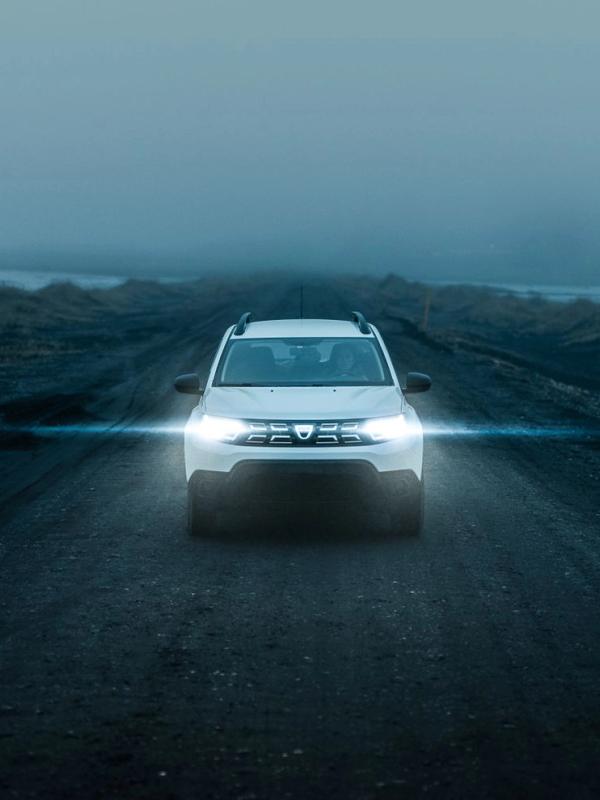
Rent a 4x4 Vehicle and Conquer Icelandic Landscapes
4x4 cars provide a sense of comfort, luxury, and safety during a road trip through a mountainous country. Not only can they handle a variety of weather, but they also offer more traction on intense roads. It is hard to know when you need a 2WD or 4WD vehicle. No need to stress, because we have got you covered! Here are our 5 Reasons Why You Should Rent a 4x4 car when exploring the land of fire and ice.
What is a 4x4 Car?
A 4X4 car is simply a car that has four-wheel drive, which means the drivetrain system directly powers all 4 wheels. It is also commonly known as 4WD. 4WD vehicles are made for off-road driving and are ideal for rough weather. This is because they have twice the traction of a 2WD car.
You may also hear the term AWD, which means all-wheel drive. This does count as a 4X4 vehicle. The difference between AWD and 4WD is that AWD is typically always on. You can toggle between having 4WD on and off. 4WD is normally found on trucks, while AWD is more for cars and SUVs. Either way, you are safer in either of these in tough road conditions than you would be in a 2WD.
Now that you know what a 4x4 car is, we are going to tell you the top 6 reasons you should rent one!
1. 4x4 Vehicles Are Allowed On F Roads
One of the biggest perks of renting a 4X4 car is the opportunity to drive Iceland’s F-Roads. An F-Road is a mountain road that has rugged terrain. You can expect dirt or gravel tracks when driving on them. The “F” in F-Road comes from the word FJall, which means mountain in Icelandic, so you can expect to be driving on mountain roads. F-roads are usually open during the summer months only. When the snow begins to fall, most of the roads become inaccessible.

F-Roads will bring you to some of Iceland’s most remote and captivating places. If you are planning to get out into the remote areas of the country, chances are you will be driving on an F-road.
There is a map of F-roads that you know where they are located before your road trip. That way you can be prepared and know what to expect. We recommended researching where gas stations are along your route and filling up ahead of time. A lot of F-roads have no shops or gas stations in sight for miles and miles.
In addition to the map, you should always check the condition and opening of Mountain Roads at Road.is.
Do you need a 4x4 Vehicle To Drive F-Roads?
These roads are illegal to drive with a 2WD vehicle, meaning you absolutely need a 4WD to access any of their locations. You are not allowed to drive F-Roads in a 2WD car and if you attempt to drive one in a 2WD rental car you will not be insured while driving on F-Roads. That means you will be liable for fines and costs of repairing any damage to the rental car. In addition to no coverage, you will also be in breach of Icelandic traffic law, resulting in a fine.
Even if you do not plan on driving an F-Road, you could change your mind during your Road Trip. It is best to save yourself some stress and rent a 4x4 vehicle that is allowed on F-roads.
2. River Crossings
If you are traveling along F-roads you will most likely run into a river crossing. While most of these are safe, you can only attempt them in a 4x4 vehicle. As long as you have the right vehicle, you can cross rivers on F-Roads. However, you do need to use some common sense when doing so. Sometimes rivers can be dangerous to cross, here are some signs you should look for.
You need to pay attention to the depth, width, and speed of the river. If you are traveling on an F-Road after heavy rainfall, the river will be faster and deeper. This would not be an ideal time to attempt the crossing, since the strong current could take the vehicle with it. This could also happen after a very sunny day due to the glaciers melting.
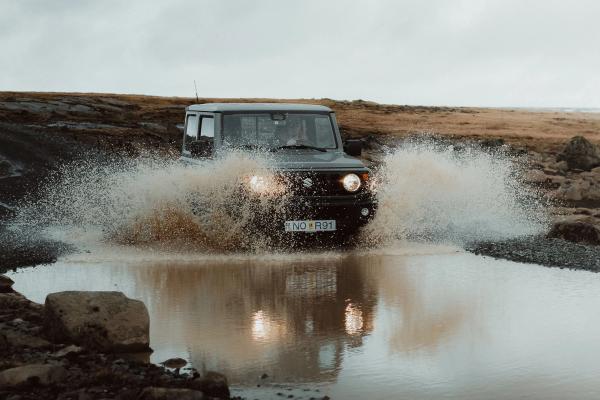
We recommended attempting river crossing on dry days where there was no heavy rainfall the day before or predicted on the day you are traveling. Also, be sure to check Iceland’s Weather Forecast before adventuring on F-Roads.
If the water of the river is higher than more than half of your tire, do not cross. If it looks higher than most of your tires, it is recommended to just turn around. The car could get completely stuck or significantly damaged. It is best to avoid you and your vehicle being in any danger. There have been multiple times tourists have sunk their rental cars when attempting river crossings. Don’t be like those tourists.
In contrast, river crossing can be so much fun and gets your adrenaline pumping. They are also necessary when visiting a lot of locations in Iceland’s highlands. Just another perk of renting a 4X4 car when traveling to Iceland.
3. 4x4s Provide Better Traction In Bad Weather
Iceland is known for its sometimes unpredictable weather. In the winter roads can be very dangerous due to ice and heavy snowfall. But, the summer has its risks too. Iceland is prone to sand storms and high winds. You can truly hit any unpredictable weather when traveling to Iceland. If you have the right vehicle you will be able to handle most weather and most 4X4 cars are meant to fight any type of weather.
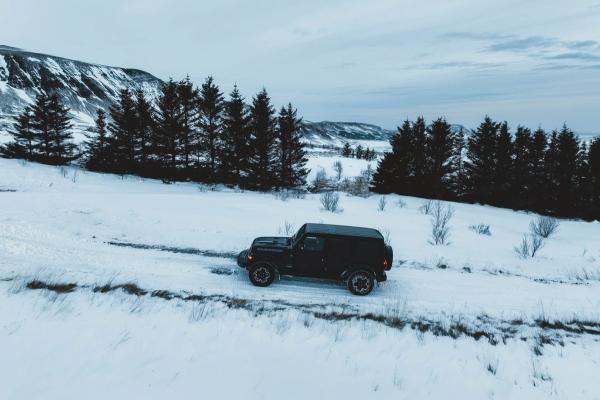
Iceland’s Weather
Snow is common during the winter months, with the heaviest snowfall between December and January. However, that does not mean you are in the clear. It can snow almost every month of the year, except for June, July, and August. It does snow throughout the country, with some places getting more snow than others.
Snow
For example, Reykjavik gets snow with an average one-inch accumulation, sometimes going up to two inches. In the Westfjords, the town of Isafjordur gets very heavy snowfall. The roads can close during the winter months, making it impossible to visit. This is more common in the north and east of Iceland. So if you want to visit towns in those areas, it is best to go in the summer months. Luckily a majority of Iceland’s roads are built for snow, in addition to being very well maintained. The Ring Road is accessible in the winter months going west and south and normally stays open. Icelanders keep the roads cleared for drivers, making it safe for those who are comfortable driving on snowy roads.
Rain
So what about rain? Iceland does not have an intense rainy season but if we had to choose one, it would be from October to January. This is more common in the southern part of the country rather than in the north. Luckily, thunderstorms should not be an issue for you. They are very rare in Iceland, with an average of five storms per year. If a thunderstorm does occur, it normally happens in the South Coast area. This is because the South Coast is warmer than Northern and Eastern Iceland.
Extreme Weather
Iceland does not have much extreme weather and the following could happen in a rare occurrence. Tornadoes are not common in Iceland, yet waterspouts have been seen over the years. A water spout is a tornado or funnel cloud that occurs over the ocean or a large body of water. The best part is that they normally stay out in the ocean. Leaving nothing to worry about for those of us on land.
Earthquakes in Iceland are considered normal, along with the rest of the world. While there are about 500 that happen weekly, almost all are unnoticeable. Big earthquakes that shake the ground and cause damage are very rare. The largest earthquake that was recorded in Iceland happened in 1784 at a 7.1 magnitude. Since then, no other earthquakes have been as intense.
Loose Gravel
Prepare for loose gravel by getting Gravel Protection in Iceland too. Iceland’s roads are unlike other countries since they have a layer of asphalt that is rougher than normal roads. The country does this to provide a steadier grip on the roads when winter hits. The gravel rock can help prevent the roads from turning into a sheet of ice. This is why paved roads tend to be more slippery and prone to car accidents when covered in snow and ice. If you choose to rent with Go Car Rental, Gravel Protection is included in your rental car price!
Sand & Ash
Around 20% of Iceland is covered in ash from volcanic eruptions. Combined with crazy weather, it can sometimes cause an ash or sand storm, especially if you are in more remote areas exploring. While most countries have endless highways and paved roads, Iceland does it a little differently. Maybe you want to drive closer to that mountain peak you’ve been dying to hike.
Or is there a dirt road that takes you to the destination of your dreams? Iceland is full of off-the-beaten-path areas that you may wind up exploring, and some of them can be sandy. 4x4 cars can handle this better than 2WD if you do find yourself in that situation. In addition to having the right vehicle, you should also get Sand & Protection when renting a car in Iceland.
What To Expect Per Season
Now that you know some of the unpredictable weather you could run into, we will go over what you can expect per season.
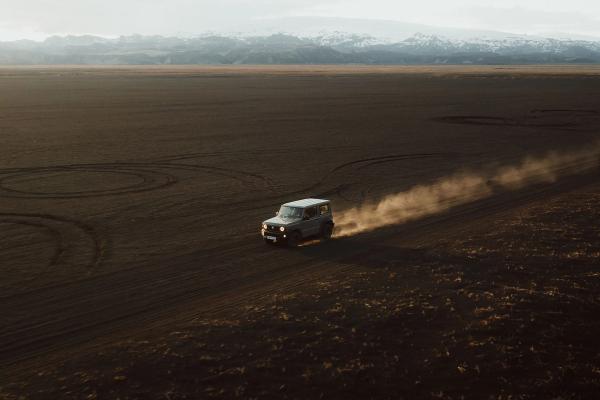
Winter: December, January, and February
If you are visiting Iceland in the winter you have to rent a 4X4 vehicle. In addition to the unpredictable weather stated above, winter in Iceland is snow packed.
January is known to be the snowiest month in Iceland, with February not too far behind. You do get more daylight hours in February, but there is not enough warmth to quickly melt the snow. Visiting during any of these months will require snow, ice, participation, and more.
Spring: March, April and May
March is still very much a part of the winter season, despite it having the first day of spring. The end of March could pull in spring temperatures and you will see them go up more heading into May.
May can still have some issues at the beginning of the month. Towards the end of the month, the weather gets warmer and snow is normally melted. This does mean river crossings can be more dangerous though, due to flowing water.
Summer: June, July and August
While you won’t need a 4x4 during summer for winter weather, you will need it for adventuring. This time of the year is one of the best times to visit the remote highlands. Thanks to the country’s long daylight hours, you will have more to explore. A 4x4 is good during summer since chances are you will explore some of Iceland’s F-Roads, which have tougher terrain.
Fall: September, October and November
Fall is similar to summer when planning a road trip through Iceland. While there may not be tons of snow yet, you will still need a 4X4 to explore offroad. There can be times when the snow starts early and roads ice over, but for the most part, there is pleasant weather during autumn. October may bring wintery conditions to more remote areas though, such as the Highlands or Eastern Iceland
4. 4x4s Allow You To Go Off The Beaten Path
While this last reason is a combination of them all, it is the main reason why you should rent a 4X4 Car in Iceland. Going off the beaten path is one of the best ways to visit Iceland. Here are some of our Top locations in Iceland to visit with a 4x4 car.
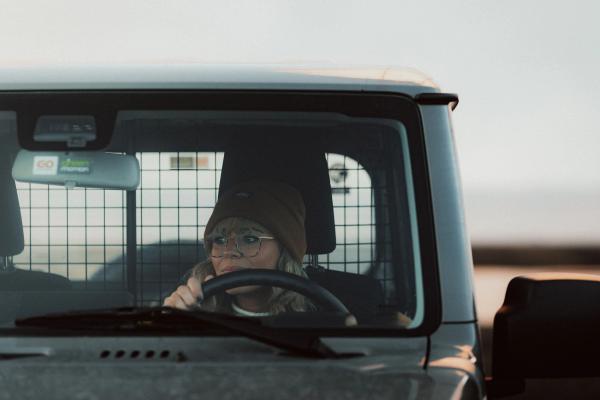
Landmannalaugar
Located in Fjallabak Nature Reserve in the Highlands is the Landmannalaugar or the 'People's Pools', You will drive through colorful rhyolite mountains and vast lava fields. This is in addition to the amazing hot springs in the area.
You can take a beautiful hike here while taking pictures of the bright-colored mountains. After, soak yourself in one of the natural geothermal pools. The easiest and most popular way to get there is by taking road F208 from the north.
Þórsmörk.
Want to visit the Valley of Thor? You can by heading to Þórsmörk, which is made up of Eyjafjallajökull, Mýrdalsjökull, and Tindfjallajökull is Þórsmörk. This nature reserve sits in the southern Icelandic highlands. It is known to be the top hiking destination in the entire country, attracting outdoor enthusiasts and photographers from all over.
The road closes in the winter but if you have a chance to visit the area in the summer, you should! You do need a 4x4 vehicle to attempt this drive. It is recommended for only experienced drivers with vehicles big enough. Talk to your rental car specialist before making this attempt. Some tours can bring you through the road if conditions don’t allow you to make it.
Maelifell Volcano
Visit the 2595-foot volcano that stands out in a desert of striking black sand. The Maelifell Volcano was once concealed under the Mýrdalsjökull glacier, which is the third-largest glacier in the country. It then became exposed when the glacier retreated at the end of the last Ice Age, around 10,000 years ago.
Today you can visit it by taking Route F210, which involves a river crossing. The road is known to be very bumpy and can take around three hours to drive. Seeing the Volcano in person is worth the drive! Just another reason to rent a 4x4 vehicle.
Askja
Visit the vast Vatnajökull National Park and see the active volcano of Askja. The volcano is located in the Northern part of the National Park, surrounded by crater lakes and lava fields.
There is also the Viti Crater. These lakes were formed from volcanic eruptions which created the crater floor. Your driving adventure on F905 to Askja will be an adventure on its own, as the views are known to be drop-dead gorgeous.
Where do you need a 4X4 car in Iceland?
In addition to the locations above, there are so many other places you may need a 4X4 car vehicle during your Iceland road trip.
Highlands
F-roads are most typical in the middle of the country, such as places like the Icelandic Highlands. The Highlands of Iceland is located on an inhabited plateau of 15,445 square miles that covers most of the center of Iceland. The highlands are made up of F-roads, which means you need a 4x4 vehicle to access them.
Snæfellsnes Peninsula
The Snæfellsnes Peninsula is home to the well-known F570 Road, which takes you around the Snaefellsjökull glacier. The peninsula is in Western Iceland and F570 (Jökulshálsvegur) is famous for being one of the most scenic roads in the country. The road will bring you through Snæfellsjökull National Park and is very steep, with a loose gravel surface, potholes, blind turns, and blind hills. The drive can only be done by 4x4 vehicles.
Westfjords
The Westfjords is located in Northwest Iceland and is home to some of the country's most beautiful landscapes. This is in addition to stunning fjords, enchanting waterfalls, coastal villages, beaches and so much more. It is a fantastic road trip destination when visiting Iceland in Summer.
The Westfjords are made up of a variety of F-Roads. Some of the areas do offer paved roads, but the F-Roads are the ones that can take you to some of the locations listed.
For example, F-Road 68 leaves the ring road and leads you up through the Strandir region of the Westfjords. Here you will find the adorable village of Borðeyri as you make your way up to Hólmavík. The road turns to gravel and has rough terrain. If you are planning to explore the Westfjords you absolutely need to rent a 4x4 vehicle
Eastfjords
The Eastfjords are known for their rough roads and grow some concern for those traveling along Ring Road. The Eastern fjords are from Höfn to the farm of Grímsstaðir á Fjöllum in Northeast Iceland. If you go down any of the side roads you 100% need a 4X4 vehicle as you will be entering F-roads in the area.
This area is known for its reindeer! So be sure to keep an eye out when traveling along this route.
North Fjords
If you are exploring remote areas in North Iceland you should be driving a 4X4 vehicle. There are two big fjords here and several smaller ones. The bigger ones are called Skagafjörður and Eyjafjörður, meaning 'Spit Fjord' and 'Island Fjord'. Eyjafjörður is at the edge of the Arctic Circle you can even visit the two islands, Hrísey island, and Grímsey island by ferry.
A lot of people pass right through this area and continue along Ring Road. But there are so many hidden gems and landscapes around the North Fjords.
Do I Need A 4X4 To Drive The Golden Circle & Ring Road?
You do not need a 4X4 on Golden Circle or Ring Road. But you may need one during your trip, especially if you want to visit any stop off of the paved road. The last thing you want is to miss out on a breathtaking location because your car cannot get to it. As stated above, you would want a 4X4 vehicle in the Eastfjord part of Ring Road. While it is not an F-Road, it can still get pretty bumpy and traction could become rough
5. Renting a 4x4 in Iceland Is Affordable!
Travelers think that renting a 4x4 means you are dishing out more cash than other vehicles. This is not necessarily true. As you can tell by all of the options listed above, there are plenty of 4X4 vehicles to go around. There is not a huge price difference between some 2WD vehicles and 4WD vehicles. Years ago 4x4 cars were more expensive but thanks to technology, these vehicles have a lot of the same benefits as 2WD cars.

Today, you are pretty much paying a small difference for extra safety and comfort. Many 4x4 vehicles are fuel efficient too. So you don’t have to budget extra money to drive the vehicle you truly want.
Some of the most fuel-efficient 4x4 vehicles listed above are Dacia Duster, Suzuki Jimny, Nissan Qashqai, and Toyota Rav4.
Your options are endless when renting a 4x4 car with Go Car Rental in Iceland!
